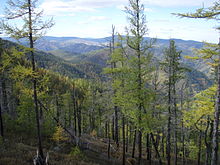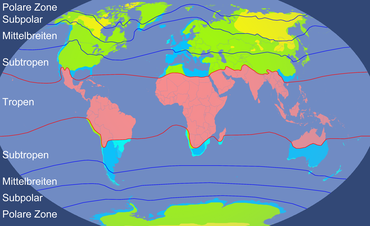Continental climate
The term continental climate (land climate) is used to describe the temperature course of various types of climate outside the tropics, which are characterized by seasonal large temperature fluctuations above 20 °C of the monthly average temperatures.
In the mid-latitudes and subtropics, hot summers and cold winters are typical of this. The continental climate is generally contrasted with the maritime climate (or oceanic/maritime climate). Compared to the latter, regions with continental climates receive little precipitation, usually with a distinct maximum in summer. Continental climates are only found in extra-tropical climate zones, because the large fluctuation in the temperature course of the annual cycle that is characteristic of continental climates does not occur in the tropics. Seasonal temperature fluctuations are only slightly pronounced there, regardless of the distance to the oceans.
The further one gets into the interior of a continent, the smaller the balancing influence of the oceans becomes, which represent an enormous heat reservoir due to the high specific heat capacity of water, while the heat capacity of the earth's soil is decoupled from the surface due to thermal resistance and lack of mixing. At the same time, both the number of clouds and the moisture content of the atmosphere decrease sharply. Continentality refers to the quantity that indicates the extent to which a region has presented typical features of continental climate. There are various proposals to index or quantify it in terms of degrees of continentality.
At mountains on the way from the sea to the continental interior the wind speed decreases, moreover the clouds are forced to rise and cannot hold so much water vapour by the following cooling. Due to its large expanse and the strongly indented landscape, Asia has a share in several climate zones, but most of all in the continental climate. Between the extreme summers and winters there are - often only short - transitional seasons. The daily temperature contrasts are also great. The cold pole is in the northeast of Siberia (both Oimjakon and Verkhoyansk), but the winters are also cold in Central Asia because of the low cloud cover and nocturnal radiation. Where the great deserts extend far to the north, the greatest temperature differences in the course of the day and year are likely to occur. In contrast, South and Southeast Asia are under the influence of the monsoon, which causes a cycle of wet and dry seasons. This is triggered by the winter-cold land masses of northern Asia, where pronounced high-pressure areas can develop.
Due to the comparatively small land masses of the southern hemisphere (with the exception of the Antarctic continent), only narrow strips of a weakly developed continental climate are found in South America and South Africa according to the definition of Siegmund and Frankenberg.

"Light larch taiga" in eastern Siberia: Region with typical continental climate

Climates of the earth by heat balance/continentality: Annual variations in monthly average temperatures: high continental climates (over 40 °C) continental climates (between 20° and 40 °C) maritime climates (between 10° and 20 °C) high maritime climates (below 10 °C) (Tropical climates)
See also
- Humid climate
- arid climate
Search within the encyclopedia